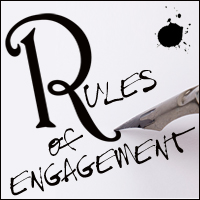.
 A notebook for fiction writers and aspiring novelists. An editor’s perspective.
A notebook for fiction writers and aspiring novelists. An editor’s perspective.
• Next post • Previous post • Index
Finding Your Voice (Part 1)
I firmly believe that finding one’s fictive voice is among the most important—yet nebulous—foundations of crafting a successful novel. Those of us who dare presume how to instruct writers usually have a vague interpretation of what establishes any specific voice. I’ve heard such sage wisdom range from the technically ambiguous; “It’s an individual writing style, one of diction, syntax, punctuation and dialogue…” to the similarly oblique; “It’s uniquely your own writing.”
So, yes—one’s voice can be an imprecise stew of indeterminable ingredients. My best guess (and this isn’t a rule, merely an intuition) is: Voice = the writer’s style (personality) + character personality. Voice is that delicate balance of your wordplay, your wit, your clarity, combined with your characters’ various personas—their wordplay (e.g.; dialog), their wit, their clarity.
Meaning that most great writers don’t write alone. (See Finding Your Voice Part 2: Do Your Characters Speak to You?)
Although for the moment, let’s concentrate on your perceptions.
One’s writing’s style might be construed as a blending of those ‘left-brain’ (mechanical) attributes, such as a conversational sentence structure, engaging vocabulary, practiced cadence and word flow, coupled with ‘right-brain’ (creative) linguistic skills that ensures the reader understands and interprets exactly the vision you’ve intended. Every word you choose to include in a novel—and every word you choose to omit—every thought, every perception, every nuance, will be unlike any other writers’. Think of your style as your literary fingerprint.
Equally as important, you must be able to preserve that singular style; a similar cadence, syntax, and cohesive ambient integrity, throughout the entire story. Stylistically speaking, if you begin your literary journey poised on the back of a snarling lion, you don’t want to end on the back of a bleating lamb. Maintaining your stylistic integrity from the first page to the last is integral.
Perhaps there is a rule at play here, at least about a writer’s stylistic intent. So Rule #9: A great novel is not so much what you tell, but how you tell it. That’s a writer’s style.
Still unsure as to what might constitute your own personal style? I don’t believe a writer chooses a style so much as it chooses you. Where to start? Sit down and begin writing with no particular destination in mind. No plot or direction or goal. You’re not starting a novel or a short story; don’t concern yourself with a beginning or end. You’re writing an abstract, a throw-away, and with no other purpose than to vomit words on paper for the sheer pleasure of doing so. You’re not worried about an audience or criticism or feedback—you’re simply attempting to please, even bedazzle, yourself. And when you begin to do so, maybe you’ve also found the beginnings of your style.
There is, within each of us, a deep and secret place where plots are bred and characters born. I’m not sure where it lingers—but I do know that when it wants me, it finds me. It exists in every writer. And as soon as your characters peek out from this hidden place, you’ll know it. You’ll soon begin to trust those voices and… ah, but that’s what Finding Your Voice (Part 2) is all about.
But first, a secret. Most editors, agents, publishers and thinking readers are able to determine a novel’s worth in the first four or five pages. Sometimes in the first four or five lines. When I read a manuscript, these are the fundamental, stylistic attributes I hope to discover in a book. (And, yes, I look in this particular order):
- Great dialogue.
- Clearly defined yet sufficiently complex characters (those who are uttering such insanely great dialog*).
- Continuity and sequencing from paragraph to paragraph. Meaning that each new paragraph is a puzzle piece that fits seamlessly with the last. Your segues are properly energized (not summarized) and information flows without the slightest confusion (unless intentional) to the reader.
- Continuity and sequencing from scene to scene. Each new scene—whether a continuation of the previous scene or an entirely new environment—is properly developed. Meaning sufficient scene/character setting is necessary: Where am I? Who’s nearby? How do I feel? What’s happening or about to happen? Yes, all a part of a writer’s style.
- Plot.
Yup. When delving into a new manuscript, your plot is the least of my concerns. Some structure must exist, of course. Getting the reader here-to-there in a cohesive, entertaining, electrifying manner is important. But during those first few pages, electrify me (and subsequent readers) with your joie de vie, with a total awareness of your characters’ complexities, cognizant of how they speak and engage and energetically carry themselves from page to page. That’s how you get me to read your book. I’d vastly prefer two amazing characters, speaking dazzling dialog in a dark room for 300 pages than all the zombies, vampires and rogue Vultarian robots gathered together in a single book to annihilate mankind. (And lose, of course.)
– – – – –
* Please do not confuse Shakespearean eloquence or elocution as a substitute for “great” dialogue. To me, great dialog is real dialogue. If “Huh?” is the quintessential response to a poignantly asked question, relevant to the character and to the moment at hand, that’s what I want to hear.
.
• Next post • Previous post • Index
.
.